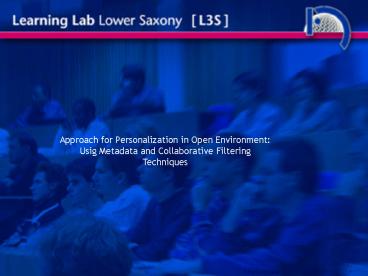L3S Overview Visit in Sweden - PowerPoint PPT Presentation
1 / 10
Title:
L3S Overview Visit in Sweden
Description:
Standard metadata to describe learning materials and user profiles (LOM, PAPI) ... Main topic, some secondary topics from a common otology ... – PowerPoint PPT presentation
Number of Views:66
Avg rating:3.0/5.0
Title: L3S Overview Visit in Sweden
1
Approach for Personalization in Open Environment
Usig Metadata and Collaborative Filtering
Techniques
2
Personalization in Open Environment
- Standards based
- Standard metadata to describe learning materials
and user profiles (LOM, PAPI) - Common ontology to classify content
- Distributed content
- Distributed metadata
- Distributed navigation information
- Adaptive functionalities implemented as queries
that take into account the user profile
3
Recommender Systems
- Content-based recommendations
- Metadata about resources is
- Created (overload)
- Extracted
- Metadata is matched against the user profile to
make personalized recommendations. - Needed
- Mapping between different metadata schema
- Matching user profile with learning objects
descriptions - Our approach until now
- Based on metadata
- Unit level personalization
- Need rich metadata set (Ex dcsubject)
- Common ontology for modeling knowledge domain and
for user knowledge
4
Recommender Systems
- Collaborative filtering
- User groups consisting of users that have similar
profiles. Recommendations for users that belong
to a group are based on results from other
members of the group - Based on implicit/explicit ratings from other
users - Drawbacks
- When there are constantly new resources added to
the system, because they have never been rated by
any other user before - High item-to-user ratio (the number of resources
is very big related to the number of users) - Explicit ratings from other users are not easily
obtained since the user has no direct reward - Hybrid systems
5
Additional Techniques
- Reputation-based retrieval
- Different weights for ratings (the opinion of an
expert is more important) - Best-seller retrieval
- Based on the most popular resources from a given
community (best seller lists). - http//www.amazon.com
- Citation-based retrieval
- Explicit references to other resources are used
(bibliography entries, links, etc) - http//citeseer.nj.nec.com/cs
- http//www.google.com/
6
Different Scenarios Different Needs
- Q Which is the optimal metadata set?
- Overload for creating metadata
- Costs
- Does it worth?
- User privacy
- A Efficient personalization is possible with
respect to the context (the learning service that
is offered) - Lecture (more close to reality)
- Main topic, some secondary topics from a common
otology - User assessments in the ontext of the lecture
- No possible interconnection of parts from several
other lectures (alternative pages explicitly
suggested by teachers, etc) - ULI context
- For students, that want a qualification, for a
specific subject, qualification that is
recognized by their university - Metadata set does not so rich
- Virtual University
- Personalization at unit level, or smaller
- Learning paths can span around multiple lectures,
etc - Reach metadata set to make user assessments
- Recommender system
7
User Modeling
- Behaviour-based model (binary model representing
what users find interesting and uninteresting,
machine-learning techniques) - Knowledge-based model (domain knowledge is used
when representing user profiles) - User Modelling in Dialog Systems Potentials and
Hazards, A. Kobsa
8
Experiments with the Quickstep recommender system
- Capturing knowledge of user preferences
ontologies in recommender systems S.E.
Middleton et al - Multi-class behavioral model (based on paper
topics) - Vector terms for paper representation, term
frequency number of terms - Inductive learning techniques (nearest neighbour
technique) to classify papers - 4 level is-a ontology for computer science
- 2 trials (14, 24 reaserchers and professors)to
compare a group of users using an ontology-based
labeling strategy with a group of users using a
flat labeling strategy - 103 research papers for the first trial, covering
17 topics and 135 papers for the second trial,
covering 23 topics - Conclusions
- Ontology users were 7-15 happier overall than
the other users - The is-a hierarchy produces a more complete
profile, by including super class topics when a
specific topic is browsed by the user
9
Issues to investigate
- Use ULI context (http//www.uli-campus.de) for
personalization - How collaborative filtering techniques can be
used for making recommendations in this context? - Create expressive user profiles and stil
maintaing user privacy. - Which would be the optimal metadata set for
personalization in this context?
10
Approach
- Formulate approach for personalization based
while investigating issues - (use the MINERVA system for implementing and
testing)































